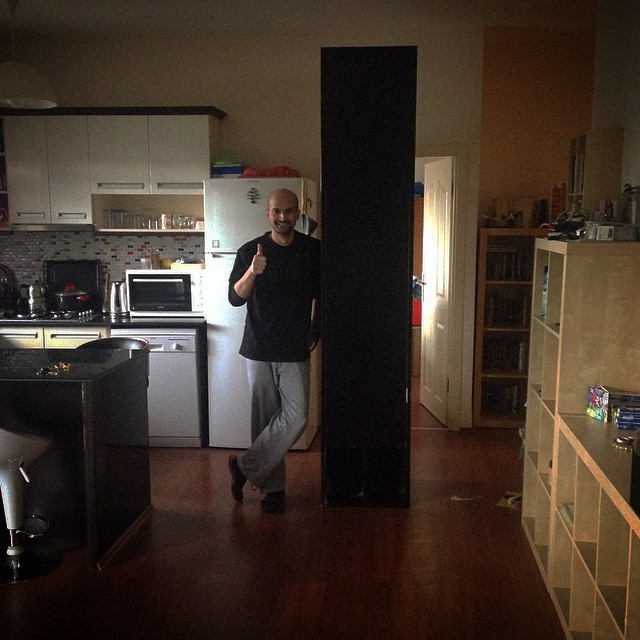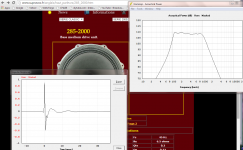Maybe my failure to make a nice contour around the JBL 2220H saved me from ruining the sound. I actually have a fairly large space between my cone and the throat with phase plug. It made enouh difference for me to keep it there. But maybe it was just like "using perfume on a pig" (local expression). The upper mids of the JBL was so disappointing at first I just had to fix them up with the phase plug. It could also be an amplification issue. I use a Bittner 800 PA amp for midbass. The idea is to replace it with a F4 or F5 and only use the Bittner for pure subwoofer duty.
Last edited:
If I didn't have the room for a large bass horn (like my spiral bass horn) I'd build a line array of woofers. Line arrays are efficient and only lose 3 db every time you double the listening distance, vs. a point source, which loses 6 d b. If you were to stack eight 10" woofers (12" if you have the ceiling height, or are willing to stagger the speakers a tad), you'd have fast bass response, plenty of power, and a fair amount of SPL per watt.
I fabricated a line array from four 18" woofers and it worked quite well. IMHO, a 10"/12" array won't move quite as much air, but it'll have the speed to keep up with the mid/hf horns.
Mmmmm would that be a mono source or 1 per side?
These horns were simmed with Hornresp, and when I attempt to enlarge the mouth, the idea gets shot down. Though the mouths seems small, the performance is spectacular.
could you explain what that means ?
what happened when the mouth was made bigger ?
I have not measured the 135 hz horn yet. My site contains a graphic depicting an RTA SPL response for the 100 hz mid bass and folded bass horn.
Hornresp doesn't like having the horn's mouth overly large and will let you know in no uncertain terms that the predicted response will not be accurate.
Hornresp doesn't like having the horn's mouth overly large and will let you know in no uncertain terms that the predicted response will not be accurate.
Hornresp doesn't like having the horn's mouth overly large and will let you know in no uncertain terms that the predicted response will not be accurate.
Hi John,
Just to clarify - the predicted response should still be pretty good
The cautionary message is shown because Hornresp uses the traditional Webster plane wavefront model with multiple-segment horns, and the calculated throat impedance starts to become inaccurate once the mouth Cir exceeds 1. This is an inherent limitation of the plane wavefront model.
Even though the throat impedance may become less accurate, the resulting power response prediction should still be good enough for all practical purposes.
I have been tempted from time to time to remove the message, but on each occasion I have ultimately decided to keep it because it provides useful information, even though it may perhaps alarm some people unnecessarily
No such Cir > 1 limitation exists with the Hornresp isophase wavefront model, which is used when simulating single-segment horns.
Kind regards,
David
Hi John,
Just to clarify - the predicted response should still be pretty good.
The cautionary message is shown because Hornresp uses the traditional Webster plane wavefront model with multiple-segment horns, and the calculated throat impedance starts to become inaccurate once the mouth Cir exceeds 1. This is an inherent limitation of the plane wavefront model.
Even though the throat impedance may become less accurate, the resulting power response prediction should still be good enough for all practical purposes.
I have been tempted from time to time to remove the message, but on each occasion I have ultimately decided to keep it because it provides useful information, even though it may perhaps alarm some people unnecessarily.
No such Cir > 1 limitation exists with the Hornresp isophase wavefront model, which is used when simulating single-segment horns.
Kind regards,
David
I appreciate you taking the time to share this with us, David. Your software is truly a fine gift and has been quite the inspiration to my horn building adventures.
I appreciate you taking the time to share this with us, David. Your software is truly a fine gift and has been quite the inspiration to my horn building adventures.
Hi John,
Your excellent horn designs should serve as exemplars to us all. Because you make minimal compromises from the theoretical ideal dimensions, your final products no doubt perform extremely well, and I suspect, compare very favourably to predicted results.
Kind regards,
David
Hi John,
Your excellent horn designs should serve as exemplars to us all. Because you make minimal compromises from the theoretical ideal dimensions, your final products no doubt perform extremely well, and I suspect, compare very favourably to predicted results.
Kind regards,
David
My horns do exactly what your software predicts. I just wish you'd add a feature that would show a pop-up advertising all the superlatives we enjoy. I.e., You're brilliant! What a great idea!! Wow, that's going to sound fantastic!!!!!
My horns do exactly what your software predicts. I just wish you'd add a feature that would show a pop-up advertising all the superlatives we enjoy. I.e., You're brilliant! What a great idea!! Wow, that's going to sound fantastic!!!!!
Has anyone simulated the Supravox 285-2000 in inlowsounds 80hz or 100hz horns. What dimensions need to change? I really like that driver and want to use that from 80hz to 350hz in a horn.
Here you go (without the adapter chamber):
Attachments
Thanks a lot Carpenter! Thanks for your sharing of knowledge over your site as well.
I am using 20hz eminence tapped horn (full scale 2,44m) with eminence 3015lf, klipschorns for midbass, Greg from Voltiaudio designed FC260 horn for midrange with BMS 4592nd-mids, and fostex t500amkII for tweeters. I am planning to change the khorn midbass with something lower in height, so I can get the midrange and tweeter closer to my ear levels and also get better response.
Do you think having 80hz inlows horn with the supravox 285-2000 will yield in better response than khorns midbass. What I mean by better response is more linear, with good detail and decay...
I am using 20hz eminence tapped horn (full scale 2,44m) with eminence 3015lf, klipschorns for midbass, Greg from Voltiaudio designed FC260 horn for midrange with BMS 4592nd-mids, and fostex t500amkII for tweeters. I am planning to change the khorn midbass with something lower in height, so I can get the midrange and tweeter closer to my ear levels and also get better response.
Do you think having 80hz inlows horn with the supravox 285-2000 will yield in better response than khorns midbass. What I mean by better response is more linear, with good detail and decay...
Yeah, the supravox will need a very nice sub with good lower midrange. I.e., not the Eminence Lab12. Lab12 is good for movie explosions, but not music.
The supravox seems like a great driver.
How about this for a good sub

kodomo,
The Supravox will be more detailed and have much better snap in a front loaded horn then the Khorns. You may have a problem at the upper end of the tapped horn (80-100hz) as most do not sound too good in that range. You will have to measure the tapped horn frequency response and see what its upper limits are. I would definitely go for the 80hz horn over the 100hz horn. That extra 20hz could make a big difference in your particular situation and give you little wiggle room.
The Supravox will be more detailed and have much better snap in a front loaded horn then the Khorns. You may have a problem at the upper end of the tapped horn (80-100hz) as most do not sound too good in that range. You will have to measure the tapped horn frequency response and see what its upper limits are. I would definitely go for the 80hz horn over the 100hz horn. That extra 20hz could make a big difference in your particular situation and give you little wiggle room.
Here you go (without the adapter chamber):
You might have found an awesome combo here!! 100-1000 at 110 is the bomb!
- Status
- This old topic is closed. If you want to reopen this topic, contact a moderator using the "Report Post" button.
- Home
- Loudspeakers
- Multi-Way
- Mid-bass horn (easy to build)
